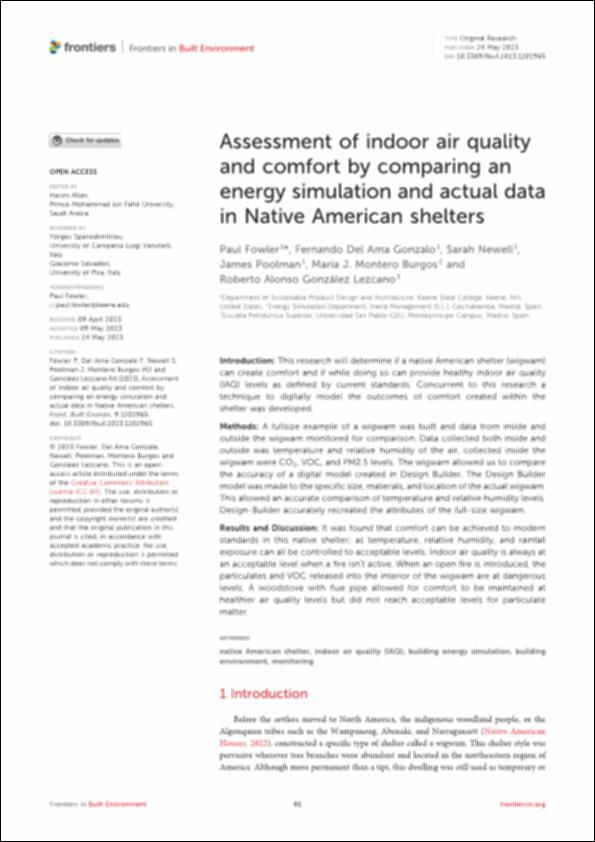Please use this identifier to cite or link to this item:
http://hdl.handle.net/10637/14670Assessment of indoor air quality and comfort by comparing an energy simulation and actual data in Native American shelters
| Title: | Assessment of indoor air quality and comfort by comparing an energy simulation and actual data in Native American shelters |
| Authors : | Fowler, Paul Del Ama Gonzalo, Fernando Newell, Sarah Poolman, James Montero Burgos, María Jesús González Lezcano, Roberto Alonso. |
| Keywords: | Hative American shelter; Indoor air quality (IAQ); Building energy simulation; Building environment; Monitoring |
| Publisher: | Frontiers Media |
| Citation: | Fowler P, Del Ama Gonzalo F, Newell S, Poolman J, Montero Burgos MJ and González Lezcano RA (2023), Assessment of indoor air quality and comfort by comparing an energy simulation and actual data in Native American shelters. Front. Built Environ. 9:1202965. doi: 10.3389/fbuil.2023.1202965 |
| Abstract: | Introduction: This research will determine if a native American shelter (wigwam) can create comfort and if while doing so can provide healthy indoor air quality (IAQ) levels as defined by current standards. Concurrent to this research a technique to digitally model the outcomes of comfort created within the shelter was developed. Methods: A fullsize example of a wigwam was built and data from inside and outside the wigwam monitored for comparison. Data collected both inside and outside was temperature and relative humidity of the air, collected inside the wigwam were CO2, VOC, and PM2.5 levels. The wigwam allowed us to compare the accuracy of a digital model created in Design Builder. The Design Builder model was made to the specific size, materials, and location of the actual wigwam. This allowed an accurate comparison of temperature and relative humidity levels. Design-Builder accurately recreated the attributes of the full-size wigwam. Results and Discussion: It was found that comfort can be achieved to modern standards in this native shelter; as temperature, relative humidity, and rainfall exposure can all be controlled to acceptable levels. Indoor air quality is always at an acceptable level when a fire isn’t active. When an open fire is introduced, the particulates and VOC released into the interior of the wigwam are at dangerous levels. A woodstove with flue pipe allowed for comfort to be maintained at healthier air quality levels but did not reach acceptable levels for particulate matter. |
| URI: | http://hdl.handle.net/10637/14670 |
| Rights : | http://creativecommons.org/licenses/by-nc-nd/4.0/deed.es OpenAccess |
| ISSN: | 2297-3362 |
| Issue Date: | 24-May-2023 |
| Center : | Universidad San Pablo-CEU |
| Appears in Collections: | Escuela de Politécnica Superior |
Items in DSpace are protected by copyright, with all rights reserved, unless otherwise indicated.


